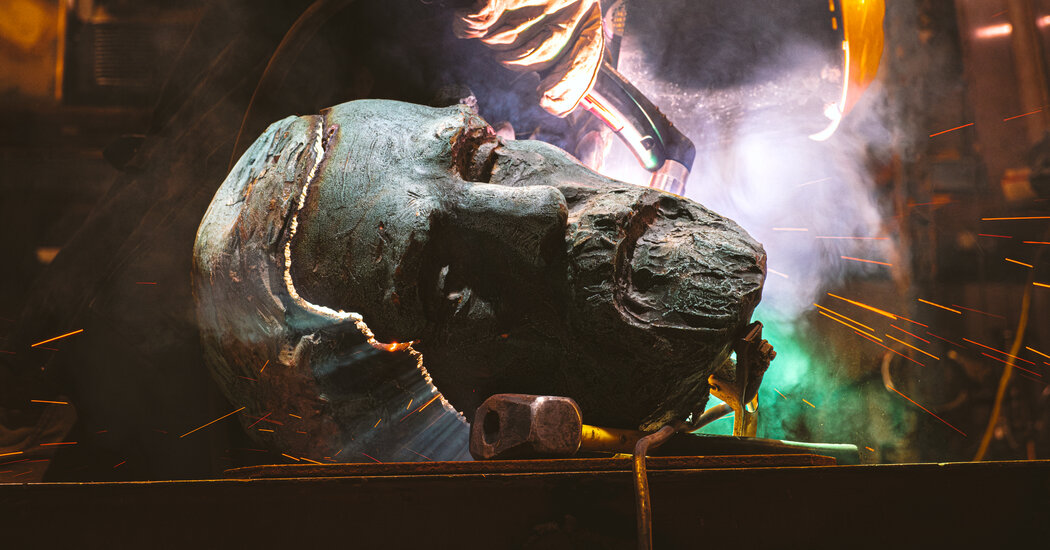Making The Melting Down of the Lee Statue a Part of Our Own History: Towards a New Art Form for Charlottesville
That is what struck me about the idea to melt Lee down, as violent as it might initially seem. Confederate monuments went up with rich, emotional ceremonies that created historical memory and solidified group identity. The way we remove them should be just as emotional, striking and memorable. Instead of quietly tucking statues away, we can use monuments one final time to bind ourselves together into new communities.
The melting down of the Lee statue will take weeks. It weighed nearly 10,000 pounds. Organizers say the next step will be choosing an artist who will craft the bronze ingots into a new art form to be displayed in Charlottesville.
One of the project’s organizers is a religious studies professor at the University of Virginia. We want to make it a piece of art that the community can be proud of and that we will not feel intimidated by.
The work is being done at an out-of-state foundry. NPR agreed not to reveal its location or the identity of the workers because they fear repercussions.
A Monument Melted Down to Create New, More Inclusive Public Art and Robert E. Lee’s “Melted Down”
The symbolism of the project is very close to the feelings of the executive director of the Jefferson School African American Cultural Center.
“The act of myth-making that has occurred around Robert E. Lee, removing his face is emblematic of the kind of removal of that kind of myth,” Douglas says.
A furnace is ignited and heats to more than 2000 degrees Fahrenheit in a side yard of the foundry. The verdigris statue is fed into a large vessel that holds General Lee’s saber.
“We are turning swords into something else,” says Douglas. “That saber is the object of violence and it was the object of power, the object of conquest. I think that is an important symbol to dig into.
Henderson is co-executive director of the Highlander Research and Education Center in Tennessee which has long been an incubator for labor and civil rights activists. She sees opportunity in this moment.
“I’m most excited about what it looks like to repair — what reparations look like for folks in Charlottesville, what it looks like to tell this new story,” Henderson says. “I think this is a joyful occasion in a really dire strait of political nastiness that we’ve been surviving.”
For the Rev. Isaac Collins, a Methodist minister, the deadly white nationalist violence in Charlottesville in 2017 was a turning point for the nation, and personally.
As a white person in this country, it was a moment that made me reexamine how I understood my country, how I understood my family, and my identity.
Source: Confederate monument melted down to create new, more inclusive public art
The Memory of W.E. Lee: A Case Study at Arlington House, the National Robert E. Lee Memorial, in Los Alamos, California
“I was thinking Humpty Dumpty couldn’t be put back together again,” says Collins. “We still have a lot of work to do, but this statue that has cost us so much, so much violence, so much hurt, so much bloodshed – it’s gone. It’s not going to be put back together the way it was.
Over the last few years, I have realized that there are two things. First, when a monument disappears without a ceremony to mark why it is coming down, a community has no chance to recognize that it has itself changed. (Ideally the ceremony is public, but because of safety concerns, the melting I attended was not.) Second, if you are outraged that something’s happening to your community’s heroic statue of Lee, you’re not going to be any less outraged if the statue is moved to some hidden storeroom than if it’s thrown into a landfill. So if all changes, large or small, will be resisted, why not go for the ones with the most symbolic resonance?
Some communities have their own visions of how Lee will be remembered, even though Swords Into Plowshares was the first to propose melting. One of the biggest changes so far has been at Arlington House, the historic plantation mansion at the center of Arlington National Cemetery, which is the official national Robert E. Lee Memorial. Arlington House reopened in 2021 with displays showing both the lives of the families enslaved there and Lee’s family who resided there after they passed it on to them. Lee was president after the war, but the site where he was buried has changed. The university decided to focus on Lee the civilian rather than Lee the general, for example by moving a prominent portrait of him in uniform. And it constructed a wall to enclose the large sculpture of Lee that once claimed an insistent place in the university’s chapel.
